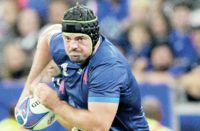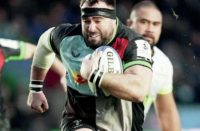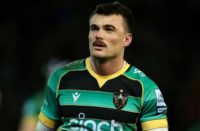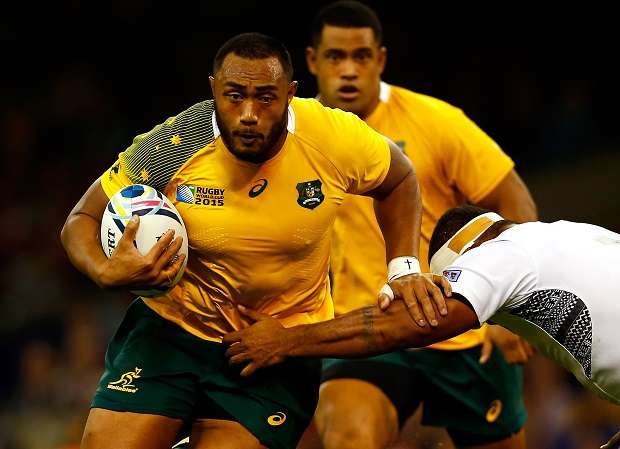 All's fair in love and war – and baggage searches – when England play Australia in any sport. That's why, after promising his fellow Aussies a war of the ‘Bodyline' variety during England's three-Test tour Down Under this month, Eddie Jones said he was not surprised to have his bags shunted into the examination queue on arrival at Brisbane airport.
All's fair in love and war – and baggage searches – when England play Australia in any sport. That's why, after promising his fellow Aussies a war of the ‘Bodyline' variety during England's three-Test tour Down Under this month, Eddie Jones said he was not surprised to have his bags shunted into the examination queue on arrival at Brisbane airport.
When Jones suggested it was all part of an Aussie plot to get under English skins, the Red Rose head coach was instantly on the receiving end of a goading response. The Aussie media wasted no time in pointing out that Jones was not only a ‘Taswegian' turncoat (in reference to his Tasmanian heritage), but had also adopted the outlook of a whingeing Pom.
For those of us who could stop themselves laughing out loud at the first instalment of what could be a lengthy sledge-fest, with Jones accused by the locals of paranoia, one thing was apparent. You did not have to be Poirot to work out that with Jones having coached the Wallabies, and become a well-known sporting figure in his homeland, it is extremely unlikely that he was selected for a search at random – especially not as the head of an official England team.
What we also know is that Michael Cheika and his Australian World Cup runners-up will be determined to send Jones' England packing with plenty of extra, unwanted, baggage at the end of June.
The Wallabies will want the sell-out crowds at the Test venues in Brisbane, Melbourne and Sydney, as well as the TV audience, to believe that having punctured England's new-found self-worth under Jones, they can beat New Zealand to retain the Southern Hemisphere Rugby Championship (truncated version) they won last year.
Cheika's Wallabies will not want to spurn their chance to knock Aussie Rules, Rugby League and football off the front pages in a domestic sporting arena where Rugby Union is in danger of becoming the back-marker.
In that sense, the return of the spiky, opinionated character like Jones is heaven sent when it comes to putting bums on armchair seats – especially when there is the added Neighbours style element of he and Cheika being buddies since their Randwick playing days.
Even so, the soap opera will be a sideshow, because the main business pre-occupying both Cheika and Jones is whether Australia will have too much power and Super Rugby pace for England to handle.
Cheika knows that Jones has reinvigorated England, and that the tourists have a rigour and a depth that was absent during their 33-13 pool stage Twickenham trouncing, when the Wallabies sent the host nation crashing out of the 2015 World Cup.
However, eight months on from the turmoil that saw Jones appointed as England coach, the pressing business for Cheika is whether Australia can raise their game to not only put paid to the tourists, but to challenge New Zealand's supremacy.
The first factor in the Wallaby coach's favour is that he has managed to keep the majority of his 2015 World Cup squad intact. Of the 23 man starting line-up who faced England only six are unavailable for this series, three of them due to injuries.
Adam Ashley-Cooper, Will Genia, Matt Giteau and Drew Mitchell are the luminaries the Wallabies have lost to Top 14 pensions, and they will be joined in the North next season by Kurtley Beale (Wasps) and Matt Toomua (Leicester).
However, with Beale ruled out against England through injury, and Toomua also unlikely to be fit in time, Cheika has to undertake a major backline overhaul during the series – and replacing the experience amassed by Ashley-Cooper (114 caps), Giteau (102 caps), Mitchell (70 caps) and Genia (66 caps) leaves a sizeable hole to be filled.
Set against that, Australia has rarely had a shortage of backline talent, and Cheika has managed to cover most eventualities by introducing a new crop of Super Rugby thrusters.
When the Wallaby coach announced his 33-man squad on Friday he plugged the gaps in the back three by introducing the robust Western Force full-back/ wing Dane Haylett-Petty and the versatile 21-year-old Rebels speedster, Reece Hodge.
On the wings he can still call on Rob Horne, and has called in the hard-running Luke Morahan, who is now with the Force but scored a brilliant solo try for the Reds against the 2013 Lions. Add the power and poundage of Taqele Naiyaravoro, the massive Fijian-born wing who made waves this season with Glasgow before returning to the Waratahs, and Cheika has a variety of options out wide.
Among his most pressing decisions is whether to employ Israel Folau at full-back, wing, or outside-centre. The long-striding Folau was in imperious form at 13 last weekend when he scored twice in the Waratahs' resounding win over the Super 18 leaders, the Chiefs. It is one selection conundrum that the Wallaby coach will not lose too much sleep over, because in the sort of form he's showing, Folau will ring England's alarm bells wherever he is picked.
Cheika is in a similar position to Jones when it comes to reshaping his midfield, with Tevita Kuridrani the incumbent at 13, and Christian Leali'ifano – who he dropped from the World Cup squad – returning as a potential play-making 12.
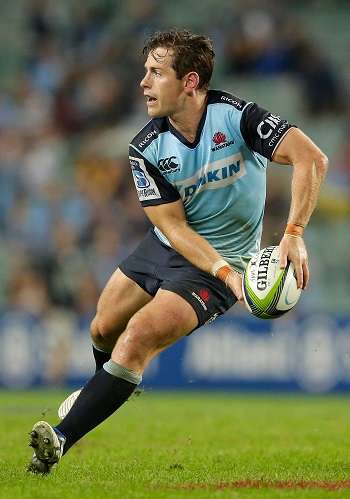 The alternative is to unleash the blockbusting Reds centre, Samu Kerevi, at 12, outside his chief string-puller, Bernard Foley, right. Waratahs fly-half Foley was the executioner-in-chief for Australia against Stuart Lancaster's side in the World Cup, producing an exceptional display when it mattered most.
The alternative is to unleash the blockbusting Reds centre, Samu Kerevi, at 12, outside his chief string-puller, Bernard Foley, right. Waratahs fly-half Foley was the executioner-in-chief for Australia against Stuart Lancaster's side in the World Cup, producing an exceptional display when it mattered most.
Foley is in his pomp at 26, and although he is only in his fourth season as an international 10, he is a growing force. What distinguishes him from most of the other fly-halves in the Test arena is that he has the priceless ability to pose a threat as a strike runner as well as being a creator.
Foley's two tries against England last October were testament to that, and Dan Carter had the same facility in his heyday. Foley creates space for the players around him because of the uncertainty he sows in the defence opposite.
With Genia out of the mix Nick Phipps is the front-runner at scrum-half, with Nick Frisby – Genia's understudy at the Reds – next in line. Phipps has an understanding with Foley forged at the Waratahs, however his service and form can be erratic, and England will try to make Foley's life hell by getting to his half-back partner.
This will involve sending Billy Vunipola down the No.8 runway into the Wallaby fly-half's channel as often as possible. England owe Foley, and bringing him down to earth with a thud will be a pre-requisite if they are to have a chance of securing a first series victory in Australia.
Another possible Achilles heel for the Wallabies is that the only cover for Foley is Leali'ifano, who plays 10 regularly for the Brumbies. While he is a skilful operator, Leali'ifano has already suffered a long catalogue of injuries, and has a goal-kicking success rate of just over 75 per cent – which, in the white heat of a close Test series, may not stand scrutiny.
To turn the screw on either Foley, or Leali'ifano, the tourists will have to emulate their Six Nations achievement of winning enough of the forward battles – individual as well as collective – to put breaking-point pressure on the Wallaby 9-10 axis.
That is a difficult mission because the Australian pack which gave England a World Cup dusting is still almost entirely intact – and should, if anything, be stronger because of greater back-row options.
They were also bolstered this week when Cheika pulled a rabbit out of the hat by announcing that seasoned tighthead, Sekope Kepu, top, had returned from Bordeaux two years early to rejoin the Waratahs, putting him straight into the Wallaby squad.
This means that Australia have the front-row that did a number on England back in harness, with captain Stephen Moore spearheading a unit that also includes Greg Holmes at tighthead, and the impressive Scott Sio at loosehead, with James Slipper as back-up. Moore also has a handy support act in the burly Tatafu Polota-Nau.
While England can boast impressive second-row depth with the advent of George Kruis and Maro Itoje, Australia also have deeper – and bigger – reserves at lock. Despite the loss of Kane Douglas, there is no shortage of giants waiting to step into the breach. With the experienced Rob Simmons going strong, and the 12-cap Sam Carter available again after injury, Cheika has two mobile lineout lighthouses.
However, the Wallaby coach has stacked his options high by recalling James Horwill from Harlequins – no doubt for the inside track on the English – and also added the 6ft 10in Rory Arnold to a crew that already includes the 6ft 8in, 22 stone (140kg) behemoth, Will Skelton.
Which brings us to the back-row, and the breakdown dominance that, along with Foley's stabbing breaks, assured the Wallaby World Cup win.
In that match Scott Fardy, Michael Hooper and David Pocock were so superior in speed and technique that they left England's back-row of Tom Wood, Chris Robshaw and Ben Morgan marooned without any quality ball.
The ‘Pooper' combination of employing two opensides, with Pocock moving to No.8, worked a treat, especially as Fardy is as accomplished at the lineout as he is as a forager.
However, with the return of Wycliff Palu alongside Ben McCalman as a No.8 specialist, Cheika also has the option of a heavyweight who can meet Billy Vunipola head-on.
The rugged Palu is also of Tongan heritage, and at 6ft 4in and 19 stone (120kg), is a couple of inches taller than Vunipola, although giving away a stone and a half in weight.
The idea that Australia will be anything less than a formidable proposition, especially on their own turf, is inconceivable. Cheika has picked a squad in which most of the players are well acquainted with each other, either through the Wallabies, or playing with or against each other in Super Rugby, or in national age grade sides. This means they will come together quickly.
If England want to avoid travelling home lugging the excess baggage of a lost series they will have two unsettle a Wallaby side which is confident, and enjoys continuity in most positions.
To crack that composure they will have to strike first – and hardest – in Brisbane.


